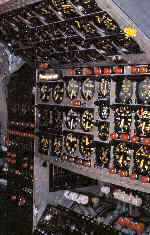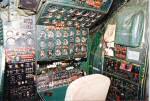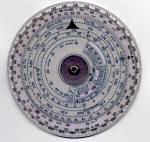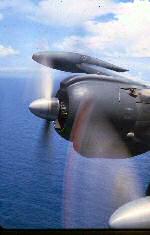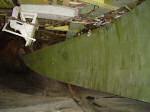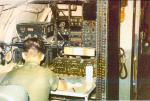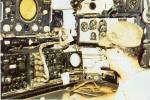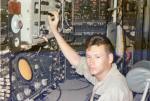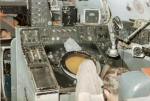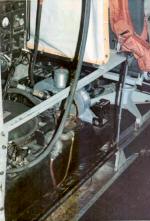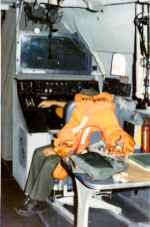Page Updated 01/29/16
Photo's of VW-1's EC-121 interior,
Photo's courtesy of Doug Pendray. '63-'64.. Unless noted otherwise
Click on picture to see larger version, Stretch or enlarge as your browser permits.
- Picture on the left: Pilot and Co-Pilot position.
2nd picture from the left: The Flight Engineers position was directly in back of the co-pilots position. Flight
Engineers were picked from the Navy aviation enlisted ratings of AD (Aviation Machinist Mate), AM (Aviation
Metal Smith), or AE (Aviation Electricians Mate). Those selected were E-5 or above, and went through 6 months
of intensive training on all systems of the aircraft. Prior to take-off they would perform critical tests to
determine the 'health' of of the aircraft engines. While in flight they would control and monitor all aspects
of the engines performance and the fuel situation. The first engineer was the not necessarily the senior
ranking individual. In many cases the 1st engineer was junior in rank to the 2nd engineer. This situation was
typical throughout all other positions of the flight crew, where position in the aircraft was selected by
qualification and training.
The 3rd picture from the left: The Flight Engineers position as viewed from the pilots seat.
Picture provided by George Therriault, VW-1 '70-'71.
The 4th picture from the left: This is the calculator that the Pilots, Flight Engineers and Navigators used.
The 1950's - 60's version of a laptop computer.
Picture provided by George Dean. 56-56 69-71 TE-5 "Good Guys"
-
- 1st picture from the left: View of 2 good engines from inside the aircraft. Engine No. 4 is the outboard
engine, the prop dome of engine No. 3 is also visable. This picture was taken from the starboard window just a
few feet forward of the galley.
2nd picture from the left: Many meals were prepared and served from the galley. Unprepared rations were
obtained from the enlisted mess halls of the base the aircraft was flying from. On long flights the main meal
would typically be beef or pork roast, with all the trimmings. Steak and eggs was the usual fare for breakfast.
These meals were usually prepared by the enlisted crew members. When the main meals were not being served crew
members could make snacks (soups and sandwiches) for themselves. During this era cigarette sample packs
(usually Marlboro,Salem or Winston) were provided for each crew member with the food obtained from the mess
halls.
3rd picture from the left: The Navigators position was just 2 or 3 steps in back of the galley. The navigator
could navigate using Radar, Loran, Radio Direction Finding or Celestial. This position also controlled the
radar ground stabilization equipment (APA-57) and the Central Gyro References System (CGRS). The CGRS was used
to stabilize the radar antenna systems as the aircraft attitude was changed.
Photo on right: The Radioman's position was just one step further aft of the Navigators position and on the
opposite side of the center isle. The 1st and 2nd radiomen maintained and operated the HF, VHF and UHF radios
and other radio equipment used for navigational purposes. Until the single side band radios became in common
use, the radiomen used Morse code to relay position reports of the aircraft, typhoons or other reports as
required by the mission being flown. The 1st radiomen was usually E5 or above.
-
- 1st. photo from the left: The 2 ECM (Electronic Counter Measures) positions were located about 3 or 4 paces
in back of the Navigators position and just forward of the Height Finder radar operator. When required the
operator could monitor frequencies from below the AM broadcast band to the SHF (Super High Frequencies).
2nd. photo from the left: The Radar Tech position was about 3 - 4 paces aft of the radioman's position, it was
filled by an E5 or above. From this position the radar tech. could monitor and control the APS-20 radar system,
IFF interrogator, bell hop or radar relay link and the electrical power configuration for the electronic
equipment. This picture shows that the radar test set used to monitor radar performance was removed.
3rd. photo from the left: The Height Finder Radar operator position was located immediately aft of the 2 ECM
operator position and across the isle from the Radar Tech position. This radar system had 6 foot 'orange peel'
antenna system located in the upper radome, immediately above this position. A CIC operator could set up his
console with a selected target and send the request to the height finder which would make its antenna
automatically point to the target bearing with a target range marker on the screen. The Height Finder operator
could then make minor adjustments to the antenna to get final bearing information and then place a marker on
the target, then press a button to automatically send the altitude information back to the requesting CIC
operator.
Photo on right: The CIC / Wx officers Position which was immediately aft of the Radar tech position. The
instrument on the left measured the barometric pressure, the instrument immediately to the right with the
yellow inspection stickers was commonly called the "Green Worm" because of its color and circular display with
a couple of squiggles in it. It measured the radar altitude of the aircraft. The Phillies cigar box was used to
keep spare grease pencils.
-
- 1st. picture from the left: The CIC (Combat Information Center) section of the aircraft contained 4 radar
consoles that could search out to 250 nautical miles. A couple of them were equipped to decode the transponder
signals from friendly aircraft. The DRT (Dead Reckoning Table), shown on the left of the picture is were maps
were placed to display fleet, aircraft or typhoon positions. The aerographers mate (weather man) position is
partially visible on the left side behind the radar console. From this position the aerographer would eject a
radiosonde and monitor weather conditions radioed back from the radiosonde as it fell by parachute.
2nd picture from the left: Close up of a typical radar console used in the EC-121. A good CIC operator could
pick up 'boggies' that were more then 200 nautical miles away, on some occasions out to 250 Nautical
Miles.
3rd picture from the left: Close up of APS-20 radar reflector in the lower radome. The reflector was 17.5 ft in
length. The 2 IFF interrogator dipole antennas can be seen at the end of the APS-20 feedhorn.
The source of this photo is not known.
-
- 1st. picture from the left: Woody Vankirk ATN2 at the radio operators position of TE-4. For some reason the
heat curtains have been removed.
2nd picture from the left: Our best guess is that is Michael Webber AX-3 at the navigators position. It appears
that the position of the APA-57 control panel has been changed and the APN-70 loran has been changed, possible
to the loran C system.
Comment from John Moehlenkamp
I don't remember if it was part of the WC-121N mod, or if all of the aircraft (145930 and 145939) got it also.
They added an APN-153 doppler navigation system and an ASN-41 navigation system. The APN-153 is self
explanatory, but I think that the ASN-41 was used to tie the output from the CGRS to the output from the
APN-153.
3rd. picture from the left: Al Garza ATR-2 at the radar operators station. Looks like he is getting ready to
make some performance checks on the APS20 radar.
4th. picture from the left: Crew 4 CIC operators taking it easy, this picture was probably taken during a
transpac. The box on left top of the console is the IFF SIF decoder, to its right is a new box, probably
another IFF decoder.
These 4 photos courtesy of Al Garza ATR-2 VW-1 66-67 TE-4
-
- 1st. picture from the left: The APS-20 radar transmitter and receiver. This equipment was positioned just
to the rear of the radioman's position.
2nd. picture from the left: The APS-45 height finding radar system.
3rd. picture from the left: This picture shows that ACO#2 was removed and replaced with a work area for the
aerographers.
Comment from John Moehlenkamp
As for the table, when the aircraft were converted to WC-121N, the middle console on the port side was removed
and replaced with a table that was used by the weather guessers. The seat in front of the weather table always
faced aft, the seat in front of ACO3 faced forward when used for weather missions (and was used for looking out
the bubble window on the port side, and other things) and aft when flying barriers in the gulf. I don't
remember the system number for the radar altimeter that was located at the station, but that is the one the
weather guessers would use to report the altitude to the cock-house every 10-15 seconds during a storm
penetration.
These 3 photos courtesy of Al Garza ATR-2 VW-1 66-67 TE-4
-
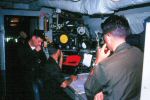
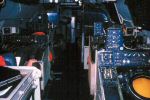
- 1st. picture from the left: Some of the flight crew watching the navigator.
2nd. picture from the left: Looking back through the CIC section from the side of the APS-45 height finder
radar.
Photo's provided by LT. Skip Richardson VW-1 '68-'70 TE-3.
-



